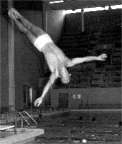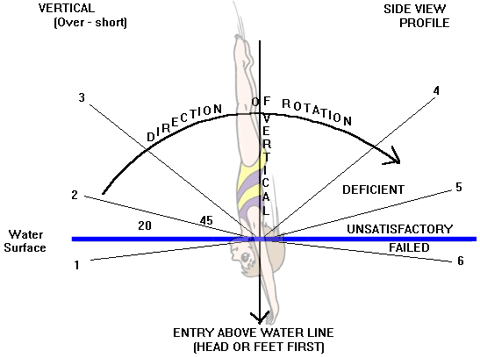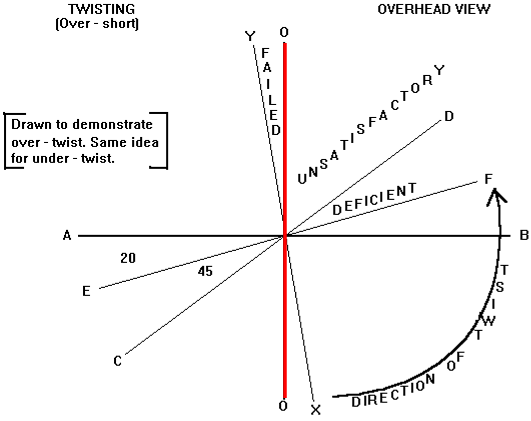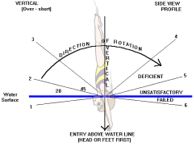
What I have tried
to do throughout my coaching career is to find a way to
judge more objectively. In order to do this; I had
to somehow deal with my own personal biases.
Having a personal bias means that there are certain things
I like to see when a dive is performed. The things I like
to see are usually the techniques I teach. Such things would
be showing the forward dive before doing the half twist or
what I consider the proper kick out sequences for various
dives. If I don't see these things happen, I may not score
the dive as high if it were closer to the techniques I teach.
The question arises, "Do we want all divers to do everything
the same and look exactly the same?" Also, do we want
all divers to do their dives my way? To extend this
thought a little further, "How many my ways are there?"
Obviously in this case, there would be one for each judge.
There are many ways to perform a dive well and my personal
biases should not get in the way of giving that dive a good
score.
One thing that upsets me is when a judge is asked, "Why did
you score that dive low?" the response is "I just didn't
like it". Early in my career I was just as guilty of judging
that way but now I feel there has to be a better way to judge
than that. This is when the idea that there are criteria in
the rulebook that have not been applied as yet. At one time,
the Forward Dive Straight was the only dive that was spelled
out in the rulebook. It has since been omitted because even
the best coaches in the world couldn't agree on what appeared
to be a simple point. "Where do you place the arms
during the dive?" Describing dives was a great idea. Because
there was no consensus, describing all dives in the diving
table would prove to be time wasted. It does seem that everyone
knows what a good hurdle looks like and what good height is.
It would seem that if there were other common parameters to
base scores on, there wouldn't be a need to describe all of
the dives.
After some thought, it seemed that over or short of vertical
was one of those parameters accepted by coaches. All that
would have to be done would be to find acceptable limits for
scoring this aspect. This is the point where the idea for
"A New Judging Angle" came to be. It seemed to satisfy
the interpretation of the rules. After using it for a while,
I like the idea so much that I began to apply the premise
to twisting dives. In both instances, I began with failed
dives and worked up from there. The intent was not to define
the perfect dive or score. It was intended to help separate
the bad dives from the really bad ones. All of this energy
has been directed toward finding an acceptable way of judging
that was more objective than subjective and more consistent
than what appears to be happening now. If a judge combined
the penalty categories with the above criteria, judging might
be more consistent and better than it has been in the past.
It should be noted that this is not intended to be the
sole criteria for basing any score.
The National Federation rulebook was the basis for the whole
idea. Only minor changes would need to be made to convert
the whole idea to the US Diving format.
A NEW JUDGING
ANGLE
After finishing
a judging clinic, a question from one of the coaches got me
to thinking about the following presentation. The question
was; "Is over / short or over / under twisting given equal
penalty weight as that of a form break?" The answer I
gave at the time was, "When it gets to a certain degree,
yes!" The word deficient has been defined only as a partial
break in position. When judging form breaks, a judge must
make a decision as to the degree of the break in order to
classify it as deficient or unsatisfactory (complete or partial).
The degree of the break will determine which range the dive
will be scored. It seemed only logical that the same could
hold true for dives that over / under rotate and dives that
over / under twist. Degree would be the answer but there needed
to be a way to determine a range for this kind of deduction.
What I was searching for was a way to better separate dives
that were good from those that had a twist that wasn't suppose
to be there and those dives that flopped over or short. This
idea was intended to be more objective and not based on bias
of a particular style or technique used to complete any given
dive.
In both diagrams, I began with the definition of failed dive
and worked up from there. The diagram for vertical was
the first because it seemed easier to come up with parameters
for judging. After years of seeing dives that entered
the water at various angles, I began to think about what score
I would give and have given dives that landed nearly flat
on the stomach or back. In most cases the score was two or
less. This is where I used a compass and noted that many
of my unsatisfactory scores where given to dives that were
within twenty degrees of horizontal.
From here I needed to set a line for deficient dives. Again
the use of a compass helped to determine that forty-five
degrees seemed to be my line of demarcation for scoring a
four. I applied the same idea to twisting and came up
with basically the same system. However to understand the
diagram, you must remember that you are viewing the diagram
from the top down rather than from a side view.
I have used this system for over seven years now and feel
quite comfortable with it. I realize that it may not be the
perfect system but it does reveal my standard for judging.
This system will also give the officials better insight into
scoring dives particularly twisters.
Point of Understanding
It should be obvious
that these two diagrams are not the only criteria for judging
dives. They do however show that these are areas are important
and should also be considered when judging.
Somersaults

In the above, placement
of the diving board either to the left or right of the diagram
would indicate the type of dive being performed. If the end
of the board were on the left, this would be Forward or Backward
rotation. If it were on the right, this would be Reverse or
Inward rotation.
Twisting

Line A-B represents
the finish of the exact amount of twist. Line 0-0 in this
drawing, represents 90 degrees past the intended twist. Most
rulebooks have interpreted this as the range for a failed
dive.
©
Copyright 1993

 |
A
RATIONALE FOR SCORING A DIVE by
Wayne Oras |
|
What I was
searching for was a way to better separate dives that
were good from those that had a twist that wasn't suppose
to be there and those dives that flopped over or short.
This idea was intended to be more objective and not
based on bias of a particular style or technique used
to complete any given dive.
|
|
